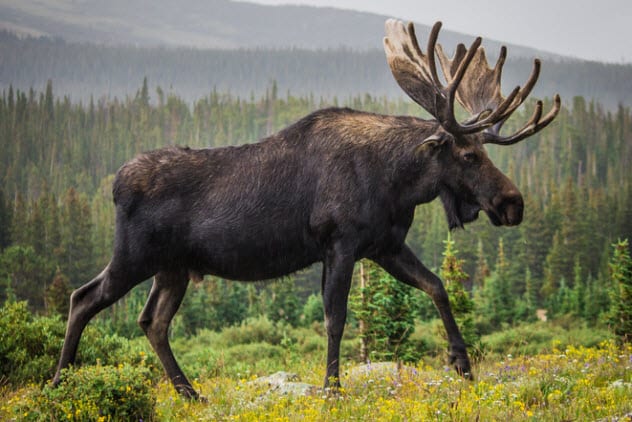 Technology
Technology  Technology
Technology  Humans
Humans 10 Everyday Human Behaviors That Are Actually Survival Instincts
 Animals
Animals 10 Animals That Humiliated and Harmed Historical Leaders
 History
History 10 Most Influential Protests in Modern History
 Creepy
Creepy 10 More Representations of Death from Myth, Legend, and Folktale
 Technology
Technology 10 Scientific Breakthroughs of 2025 That’ll Change Everything
 Our World
Our World 10 Ways Icelandic Culture Makes Other Countries Look Boring
 Misconceptions
Misconceptions 10 Common Misconceptions About the Victorian Era
 Mysteries
Mysteries 10 Strange Unexplained Mysteries of 2025
 Miscellaneous
Miscellaneous 10 of History’s Most Bell-Ringing Finishing Moves
 Technology
Technology Top 10 Everyday Tech Buzzwords That Hide a Darker Past
 Humans
Humans 10 Everyday Human Behaviors That Are Actually Survival Instincts
 Animals
Animals 10 Animals That Humiliated and Harmed Historical Leaders
Who's Behind Listverse?

Jamie Frater
Head Editor
Jamie founded Listverse due to an insatiable desire to share fascinating, obscure, and bizarre facts. He has been a guest speaker on numerous national radio and television stations and is a five time published author.
More About Us History
History 10 Most Influential Protests in Modern History
 Creepy
Creepy 10 More Representations of Death from Myth, Legend, and Folktale
 Technology
Technology 10 Scientific Breakthroughs of 2025 That’ll Change Everything
 Our World
Our World 10 Ways Icelandic Culture Makes Other Countries Look Boring
 Misconceptions
Misconceptions 10 Common Misconceptions About the Victorian Era
 Mysteries
Mysteries 10 Strange Unexplained Mysteries of 2025
 Miscellaneous
Miscellaneous 10 of History’s Most Bell-Ringing Finishing Moves
Top 10 Strangest Farms From Around The World – 2020
Farming was one of the great steps in the development of human civilisation. The ability to grow the necessities of life freed humans from the need to scavenge and live a nomadic lifestyle. Now for our convenience almost everything is produced by intensive agriculture. Some types of farming are done on a smaller scale however, if the things they produce are more unusual.
Here are ten of the strangest farms in the world, or above it.
10 Horrifying Facts About Baby Farms
10 Snake Farm
The Queen Saovabha Memorial Institute in Bangkok is both a popular tourist site and important farm. The animals they produce are less cuddly than cows but they can still be milked. They farm venomous snakes and extract their venom to produce cures for snake bites and perform research.
The anti-venoms made here are vital to curing people who get bitten by snakes. Using their thousands of venomous snakes and a steady hand the researchers at the snake farm force their reptiles to bite onto jars. As the venom drips from their fangs it is collected and used to make the anti-venom. Those who want to see how this works can pay a small fee to watch a deadly snake being milked.
Other snake farms exist around the world and it turns out snakes are unexpectedly good domestic animals. As long as they are fed and kept warm they are quite happy hanging out in drawers until they are milked.[1]
9 Spider Goats
A goat may not seem like the most exciting of animals but Freckles, along with her sisters, is not just any goat. She is part spider and part of the synthetic biology revolution. Scientists at Utah State University were interested in the properties of the drag silk spiders use to break their fall. It is stronger than Kevlar and might have uses in surgery.
The problem is that spiders can be tricky to farm. If you put cows close together they feel comfortable. If you put spiders too close together they tend to turn cannibalistic. You don’t want your farm animals to eat each other. So researchers introduced the genes that make spider silk to goats. All they have to do now to gather the silk proteins they are interest in is milk their goats.
Once purified and turned into fibres, known as BioSteel, the silk proteins are up to ten times stronger than steel of the same thickness and can be stretched up to 20 times its length without breaking.[2]
8 Moose Farm

Moose milk is pretty extraordinary stuff. It has more essential amino acids than cow’s milk. It also has double the amount of fat and is slightly pine scented. The problem is that moose are big, heave, and pretty wild. At the Ivan Susanin Sanatorium in Russia the milk from moose is regularly used to treat a range of illnesses.
The moose that produce the milk are not kept on the farm but range around the local forests until they return to the farm to give birth. It is then that the farmers perform the slightly risky job of milking the moose. To ensure that their moose do not wander off completely they are fitted with radio trackers.
The farm doesn’t actually make much money from its milk, despite its reputed health benefits. Because of the limited amounts of milk that are produced only once per year the farm makes most of its money from the tourists who come to see the moose.[3]
7 The Pope’s Farm
Castel Gandolfo was bought in the 16th century as a summer residence for the Pope. As well as a holiday home for the head of the Catholic church Castel Gandolfo also features 62 acres of farmland that produced crops exclusively for the use of the Vatican.
Or it did until Pope Francis took over. He has not stayed overnight there and has opened it up to visitors in a way that it never has been before. Tourists can even get there on a train from Vatican City on a train that once only the Pope got to use. The produce of the Pope’s farm can now be bought by anyone who wants some sanctified agricultural products.
The chickens on the farm are particularly holy. They eat the leftover dough from communion wafers that are made by nuns on the site.[4]
6 Body Farm
When you plant something at a farm you usually do so in hopes that something will spring up for you to harvest. On a body farm however you probably want your crops to stay in the ground. Body farms exist to allow researchers to follow the process of bodies decomposing.
At a body farm human bodies are left outside in various conditions. Researchers then monitor the state of the bodies. By creating a timeline of decomposition it helps police to figure out how long a body has been outside. One of the methods they use is to see which insects and other animals begin to eat the bodies and when.
“If a bone has squirrel gnawing, it’s been there at least a year. So squirrels are a time since death indicator, and squirrels tend to gnaw on the bones in the spring, apparently for the calcium for their new litter, and you can even see annual cycles of squirrel gnawing.”
Most bodies planted on the farms come from those who have donated their cadavers to science. Some people specifically leave their bodies to body farms to help with the research.[5]
Top 10 Horrific Farming Nightmares
5 Cannabis Farms
Drugs are big business. Because of the medicinal properties of many illicit drugs even governments can be in the drug growing business. Their farms tend to be out in the open, if heavily guarded. But where cannabis is illegal growers have been forced to get creative in where they put their farms.
Sometimes given away when it snows because the roof is so hot it melts off. In Britain one cannabis grower converted a former nuclear bunker into a farm with over 800 plants in it. Using expensive lighting and watering systems he was able to grow his plants underground.
Other cannabis farmers convert their attics into growing rooms. This has the advantage of hiding the light that the farms require to be on all day long. It comes with its own downside in cold climates however. The heat of the farms hidden under the roof is sufficient to melt any snow that may fall on it. All police have to do is look for the one house without a snowy roof and the farm is busted.[6]
4 Leech Farms
Leeches have been used in medicine for hundreds of years. To feed the need for leeches they had to be gathered from waterways where they lived naturally. Leech collecting used to be one of the worst jobs going because the best way to attract a leech was to simply wade into a pond or river and let them bite you. Once a leech had latched on the collector had to wait until they were fat with blood before picking them off.
Today leeches still have their uses in medicine even if the once popular practice of blood-letting has thankfully died out as a cure-all. Because they feast on blood leeches produce a powerful anticoagulant to keep the blood flowing. Attaching leeches after surgery helps blood reach the site of injuries. Luckily we have figured out ways to farm them.
To breed leeches farmers now use sausage casings filled with sheep blood. The leeches bite this, instead of the farmer, once every six months. Once grown to full size they are packaged and sent out to hospitals for a snack/ new career in medicine.[7]
3 Pig Toilets
Pigs are not picky eaters. In past centuries it was common to see pigs wandering around in towns and villages snacking on anything that humans had thrown away. In other places however pigs were, and still are, kept in toilets to eat human waste.
In ancient China pigsties were built with a latrine above it. When people went to the toilet they were doing two jobs, not just a number two. In rural China the same symbol was used for both toilet and pigsty because this method of feeding pigs was so common. Once human waste had passed through a pig the manure was much less likely to spread disease. It was an easy and effective way of dealing with sewage.
Unfortunately feeding pigs sewage is a bad idea, especially if you then eat the pig. Parasites that live in both pigs and humans can spread quickly when they each feed off each other. In most places the use of pig toilets in farming has been banned but some societies still use them and prize the meat that is produced.
2 Space Farm
If humans ever want to colonise space then they will have to come up with ways to grow food without the benefit of Earth under them. While plants have been grown on space stations and satellites before the crops were always sent back home – not for lunch but for study by scientists.
It was only in 2015 that astronauts first ate food produced in space. Using a system known as Veggie the astronauts on the International Space Station grew their first crop of Red Romaine Lettuce. By using LEDs as a source of light for the plants the system doesn’t waste energy on producing heat. They can also be tuned to specific wavelengths that can best be used by different crops for maximum efficiency.
Since then cabbages, mustard, kale, and pak choi have all been grown on the ISS. On Earth the Veggie system has been tested on over a hundred different plants so the menu of the first restaurant in space is likely to be fairly expansive.[8]
1 Bird Nests
Soups are pretty easy meals to make and benefit from the fact you can throw almost any ingredient you happen to have to hand in them. That hasn’t stopped people looking for extra rare foods to add to their soups. Bird nest soup is a delicacy made almost entirely from the spit that swiftlet birds use to create their nests. When the nests are dissolved in a soup they produce a gloopy texture that is particularly sought after.
The problem is that the birds create their nests in hard to reach places. Traditionally those who collected the nests clambered up bamboo poles to cut the nests down. The difficulty and danger of this has made the dried bird nests among the most expensive animal food products in the world.
Collecting swiftlet nests has caused populations of the birds to fall. One way of reducing this impact is to build swiftlet farms. In Indonesia these are often large concrete structures resembling houses with plenty of space inside for the nests to be built on. Instead of destroying the nests before chicks have hatched the farmers wait until the breeding season is over which helps to keep the swiftlet population up.
Still, despite now being a farmable commodity bird nest soup is still expensive. Or expensive for a dish of bird saliva.[9]
10 Bizarre Ways Growers Guard Pot Farms








